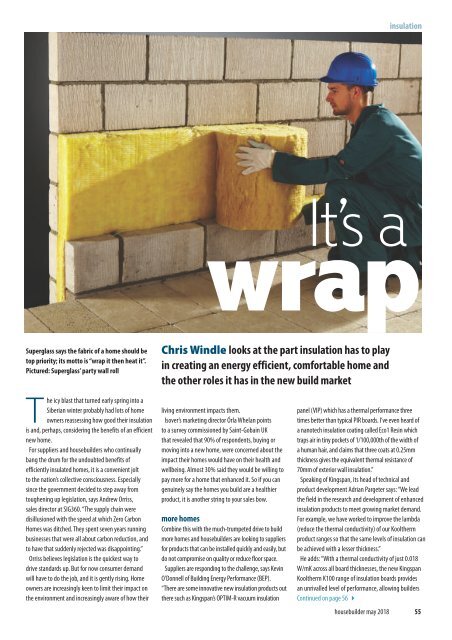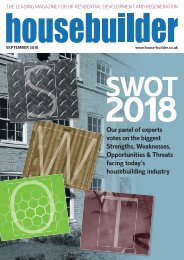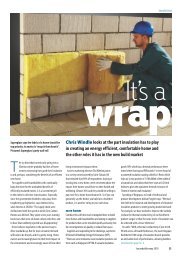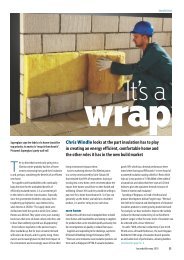Insulationf eature Housebuilder May
You also want an ePaper? Increase the reach of your titles
YUMPU automatically turns print PDFs into web optimized ePapers that Google loves.
insulation<br />
It’s a<br />
wrap<br />
Superglass says the fabric of a home should be<br />
top priority; its motto is “wrap it then heat it”.<br />
Pictured: Superglass’ party wall roll<br />
Chris Windle looks at the part insulation has to play<br />
in creating an energy efficient, comfortable home and<br />
the other roles it has in the new build market<br />
The icy blast that turned early spring into a<br />
Siberian winter probably had lots of home<br />
owners reassessing how good their insulation<br />
is and, perhaps, considering the benefits of an efficient<br />
new home.<br />
For suppliers and housebuilders who continually<br />
bang the drum for the undoubted benefits of<br />
efficiently insulated homes, it is a convenient jolt<br />
to the nation’s collective consciousness. Especially<br />
since the government decided to step away from<br />
toughening up legislation, says Andrew Orriss,<br />
sales director at SIG360. “The supply chain were<br />
disillusioned with the speed at which Zero Carbon<br />
Homes was ditched. They spent seven years running<br />
businesses that were all about carbon reduction, and<br />
to have that suddenly rejected was disappointing.”<br />
Orriss believes legislation is the quickest way to<br />
drive standards up. But for now consumer demand<br />
will have to do the job, and it is gently rising. Home<br />
owners are increasingly keen to limit their impact on<br />
the environment and increasingly aware of how their<br />
living environment impacts them.<br />
Isover’s marketing director Órla Whelan points<br />
to a survey commissioned by Saint-Gobain UK<br />
that revealed that 90% of respondents, buying or<br />
moving into a new home, were concerned about the<br />
impact their homes would have on their health and<br />
wellbeing. Almost 30% said they would be willing to<br />
pay more for a home that enhanced it. So if you can<br />
genuinely say the homes you build are a healthier<br />
product, it is another string to your sales bow.<br />
more homes<br />
Combine this with the much-trumpeted drive to build<br />
more homes and housebuilders are looking to suppliers<br />
for products that can be installed quickly and easily, but<br />
do not compromise on quality or reduce floor space.<br />
Suppliers are responding to the challenge, says Kevin<br />
O’Donnell of Building Energy Performance (BEP).<br />
“There are some innovative new insulation products out<br />
there such as Kingspan’s OPTIM-R vacuum insulation<br />
panel (VIP) which has a thermal performance three<br />
times better than typical PIR boards. I’ve even heard of<br />
a nanotech insulation coating called Eco1 Resin which<br />
traps air in tiny pockets of 1/100,000th of the width of<br />
a human hair, and claims that three coats at 0.25mm<br />
thickness gives the equivalent thermal resistance of<br />
70mm of exterior wall insulation.”<br />
Speaking of Kingspan, its head of technical and<br />
product development Adrian Pargeter says: “We lead<br />
the field in the research and development of enhanced<br />
insulation products to meet growing market demand.<br />
For example, we have worked to improve the lambda<br />
(reduce the thermal conductivity) of our Kooltherm<br />
product ranges so that the same levels of insulation can<br />
be achieved with a lesser thickness.”<br />
He adds: “With a thermal conductivity of just 0.018<br />
W/mK across all board thicknesses, the new Kingspan<br />
Kooltherm K100 range of insulation boards provides<br />
an unrivalled level of performance, allowing builders<br />
Continued on page 56 4<br />
housebuilder may 2018 55
insulation<br />
corners, with high U-values and is made from up to<br />
84% recycled glass.”<br />
Of course creating the healthy home mentioned<br />
earlier is not just about energy efficiency, says Tracey<br />
Dempster, head of marketing at Saint-Gobain Weber.<br />
“Insulating properties without due consideration to<br />
condensation and ventilation issues can be damaging to<br />
the health and wellbeing of building users. But equally,<br />
if you insulate correctly it will have a positive influence<br />
on those who use that space. To strike the balance,<br />
it’s all about understanding the relationship between<br />
insulation, condensation and ventilation, knowing what<br />
you’re starting with, in the case of a refurbishment<br />
project, and sourcing the correct advice.”<br />
With this in mind Weber’s multi-comfort strategy aims<br />
to overcome condensation, thermal bridging and poor<br />
Insulation and fire safety<br />
<strong>Housebuilder</strong>s should think carefully about<br />
the fire safety of the insulation they specify in<br />
buildings higher than 18m says Rockwool head<br />
of technical Tim Vincent.<br />
Approved Document Part B requires that<br />
external walls adequately resist the spread of<br />
fire in such buildings, while MHCLG guidance<br />
states that all the elements of a wall should be<br />
of limited combustibility.<br />
But these are ambiguous terms and it is<br />
vital housebuilders are aware how “noncombustible”,<br />
“limited combustibility” and<br />
“combustible” are defined in the Euroclass<br />
system – the harmonised European method of<br />
classifying the reaction to fire performance of<br />
Continued from page 55<br />
to work with their preferred construction sizes while<br />
easily meeting current standards.”<br />
Saint-Gobain Weber product manager Kelvin Green<br />
says: “We’re innovating to develop products that set<br />
faster, allowing housebuilders to finish the job more<br />
quickly.” He points to the company’s polymer-modified,<br />
cement-based mortar, weberend LAC rapid, which can<br />
be applied in two passes as an example of this. The<br />
company’s webertherm XP external wall insulation (EWI)<br />
system is also designed to be fast and simple to install,<br />
using glass fibre mesh reinforcement and webertherm<br />
M1 render which is suitable for machine application.<br />
Using high performance products will help to ensure<br />
a housebuilding boom leaves a positive legacy –<br />
homes that are still being enjoyed in 100 years’ time.<br />
It would be a huge shame to let that opportunity slip.<br />
The key to this, says Sarah White, residential sector<br />
manager at British Gypsum, is getting the fabric<br />
of a building right from the start without reducing<br />
56 housebuilder may 2018<br />
products – says Vincent.<br />
There are seven classification levels, from A1<br />
to F, plus a no performance declared rating,<br />
and they are mandatory for all CE marked<br />
construction products. “The Euroclass system<br />
states that products achieving A1 classification<br />
are defined as non-combustible. Products<br />
achieving an A2 classification are recognised<br />
as products of limited combustibility, offering<br />
no significant contribution to fire growth.<br />
Products achieving a rating of B to F are<br />
deemed to be combustible.”<br />
In short, non-combustible equals noncombustible.<br />
Other terms such as fire safe,<br />
fire proof, fire retardant or flame proof do not<br />
necessarily mean a product is non-combustible.<br />
floor space. “If you can do this by exceeding Building<br />
Regulations, from design through to installation,<br />
you’re adding value to the end user.”<br />
She adds: “British Gypsum has introduced four<br />
variations – Gyproc ThermaLine BASIC, Gyproc<br />
ThermaLine PLUS, Gyproc ThermaLine SUPER and Gyproc<br />
ThermaLine PIR – in order to support housebuilders<br />
in choosing the correct thickness for their specific<br />
performance requirements. With Gyproc ThermaLine PIR<br />
proving to be the most popular due to its combination of<br />
high performance and minimal thickness.”<br />
“wrap it then heat it”<br />
Bob Dalrymple, head of marketing at Superglass,<br />
agrees that the fabric of a home should be top priority,<br />
which is why its motto is “wrap it then heat it”. A well<br />
wrapped home “not only keeps heating bills down<br />
but also complements green technologies.” He adds:<br />
“Our glass wool is especially effective as it is flexible<br />
enough to fully envelope a building, including sharp<br />
Kingspan’s OPTIM-R E roofing system comprises<br />
both OPTIM-R E panels and OPTIM-R Flex infill<br />
strips and is suitable for applications on flat<br />
roofs, terraces and balconies<br />
energy performance. This includes calculating target<br />
U-values when specifying external wall insulation and<br />
undertaking a condensation risk analysis.<br />
This kind of service is growing as suppliers seek<br />
to provide a more complete package. They can<br />
help housebuilders navigate their way through the<br />
specification process, since, as O’Donnell of BEP points<br />
out: “There’s so much choice in the market at the<br />
moment, choosing an appropriate insulation for the<br />
specific home is a key factor. This could depend on<br />
the wind driven rain exposure category of the site,<br />
whether a timber frame or traditional masonry cavity<br />
is the preferred choice of construction, or the overall<br />
wall thickness desired.”<br />
“We’re committed to constantly improving our customer<br />
service and bespoke product offering,” says Dalrymple<br />
of Superglass. “Our in-house specification and technical<br />
teams provide U-value calculations, dew point analysis,<br />
condensation risk analysis and Building Regulation<br />
compliance as part of a free service for customers.”<br />
He adds: “We are investing tens of millions over<br />
the next couple of years into upgrading our Stirling<br />
Continued on page 58 4
insulation<br />
Turning the volume down<br />
Acoustic insulation may not grab the headlines<br />
in the same way as its energy efficient sibling<br />
but it can make all the difference to the quality<br />
of life in a home. Which is why Isover launched<br />
its Sound Good Factor in 2017.<br />
Órla Whelan of Isover explains: “The<br />
campaign showcases the types of noise<br />
that can happen within homes and how<br />
Isover products can help minimise them and<br />
maximise acoustic comfort.”<br />
“Despite glass mineral wool insulation often<br />
being viewed as a material that solely affects<br />
the thermal performance of a property, it can<br />
also help to improve the acoustics of a building<br />
significantly because it naturally absorbs sound<br />
and drastically reduces the transfer of noise.”<br />
Metac, for instance, is a cost effective high<br />
performance mineral wool developed for<br />
pitched roof rafter applications, which can<br />
help to enhance acoustic comfort by reducing<br />
external noise, from sources such as planes,<br />
trains, traffic and adverse weather.<br />
Whelan claims: “In an independent test,<br />
Metac provided a weighted sound reduction<br />
of up to 49dB(Rw). What’s more, it offers a<br />
thermal conductivity of 0.034W/mK and is<br />
available in a variety of thicknesses (50mm<br />
– 200mm), to allow housebuilders to meet a<br />
wide range of U-values.”<br />
Weber’s webertherm XP external wall insulation (EWI) system is designed to be fast and simple to install<br />
KEY CONTACTS<br />
Building Energy Performance www.bepltd.co.uk<br />
British Gypsum www.british-gypsum.com<br />
Isover www.isover.co.uk<br />
Kingspan www.kingspan.com<br />
SIG360 www.sig360.co.uk<br />
Superglass www.superglass.co.uk<br />
Weber www.netweber.co.uk<br />
Continued from page 56<br />
manufacturing site, bringing in new machinery<br />
and expanding our research and development and<br />
customer service operations.”<br />
Kingspan, says Pargeter, offers a specialist installation<br />
design service for its OPTIM-R E roofing system which<br />
comprises both OPTIM-R E panels and OPTIM-R Flex<br />
infill strips and is suitable for applications on flat roofs,<br />
terraces and balconies. The service provides “detailed<br />
58 housebuilder may 2018<br />
Kingspan’s new Kooltherm K100 range of<br />
insulation boards provides an unrivalled level of<br />
performance, it says<br />
layouts and instruction with every installation to<br />
guarantee the ratio of panels to flex infill strips is<br />
maximised for each project. The panels arrive on site as<br />
part of a system, designed to the building’s dimensions,<br />
and do not require any extra cutting or moulding,<br />
making them ideal for tight timescales.”<br />
Orriss of SIG360, which helps developers design<br />
systems and specify products, says: “Our software<br />
creates a 3-D model of a home which we can examine<br />
to work out what the energy performance would be<br />
like and how it could be improved.” In the near future<br />
he believes this kind of technology could have further<br />
beneficial applications for housebuilders. “By creating<br />
3D house types they’re just a short step from allowing<br />
customers to take a virtual reality tour of a new home.<br />
British Gypsum has introduced four variations<br />
of product to help housebuilders choose the<br />
correct thickness for their specific performance<br />
requirements<br />
Which would be great for the industry.”<br />
In fact technology, rather than the products<br />
themselves, is where Orriss sees the greatest leaps in<br />
innovation coming next. “There’s lots of opportunity<br />
to use tech to improve the process,” he says, pointing<br />
out, for example, the advantages of collaboratively<br />
discussing a 3-D model with all stakeholders and<br />
making revisions in real time.<br />
Suppliers may not be able to stop the Beast from the<br />
East returning one day but by constantly improving<br />
what they offer, they can make sure it does not sink its<br />
chilly claws into any new homes. hb
2018 HOUSEBUILDER<br />
MOUNTAIN MARATHON<br />
The ‘<strong>Housebuilder</strong> Mountain Marathon’ (21-23 September 2018),<br />
sponsored by Barratt, Crest Nicholson, Linden Homes and Taylor<br />
Wimpey has proved to be extremely popular. Over 30 teams have<br />
now entered to take on this two-day challenge up and over the tough,<br />
but beautiful mountains of Snowdonia. The marathon has long been<br />
held as the pinnacle of endurance and now it is being taken to the<br />
next level, in this industry mountain challenge.<br />
The aim is to raise over £100,000 for Youth Adventure Trust, who<br />
support vulnerable young people, who face their own challenges on<br />
a daily basis.<br />
There are still a few team places left, so get a team (of 4 – 6) together<br />
and by taking on your own challenge, you’ll be helping young people<br />
to build the confidence and resilience to face their own. Team places<br />
cost £1,500 with a minimum sponsorship target of £3,600 per team.<br />
Contact sharon.axford@taylorwimpey.com for more information.







